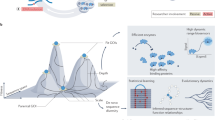Abstract
Redundant elements in proteins and nucleic acids serve to buffer the effect of point mutations on features of conformation critical for function. Mutation buffering associated with mechanistically redundant amino acids facilitates the evolution of proteins. Such redundant amino acids accumulate by hitch-hiking along with the evolutionary advances which they facilitate. Redundancies in DNA (such as introns and repetitive DNA) prevent extraneous sequence dependent conformational effects from interfering with readout. They also facilitate regulatory evolution. According to the mutation buffering concept biological organizations are selected to facilitate evolution. As a consequence biological information processing is very different from information processing in man-made computers. The link between molecular conformation, evolutionary processes, and information processing is formulated in terms of a tradeoff principle. By utilizing mutation buffering biological systems sacrifice programmability; by achieving programmability digital computers make mutation buffering computationally expensive and hence sacrifice evolutionary adaptability.
Similar content being viewed by others
References
Allen, P. M. and Ebeling, W. (1983)BioSystems,16, 113.
Azorin, F., Hahn, R. and Rich, A. (1984)Proc. Natl. Acad. Sci. USA,81, 5714.
Conrad, M. (1974a)J. Theoret. Biol.,45, 585.
Conrad, M. (1974b)J. Theoret. Biol.,46, 167.
Conrad, M. (1977)J. Mol. Evol.,10, 87.
Conrad, M. (1978) inTheoretical Approaches to Complex Systems (eds R. Heim and G. Palm) (Heidelberg: Springer Verlag), p. 147.
Conrad, M. (1979a)Bull. Math. Biol,41, 387.
Conrad, M. (1979b)BioSystems,11, 167.
Conrad, M. (1981)BioSystems,13, 303.
Conrad, M. (1982)BioSystems,15, 83.
Conrad, M. (1983)Adaptability: The Significance of Variability from Molecule to Ecosystem (New York: Plenum Press).
Conrad, M. (1984)BioSystems,16, 345.
Conrad, M., Friedlander, C. and Goodman, M. (1983)BioSystems,16, 101.
Conrad, M. and Volkenstein, M. (1981)J. Theoret. Biol,92, 293.
Gupta, G., Bansal, M. and Sasisekharan, V. (1980)Int. J. Biol Macromol.,2, 368.
Kimura, M. (1968)Nature (London),217, 624.
King, J. L. and Jukes, T. H. (1969)Science,164, 788.
Kirkpatrick, F. H. (1979)BioSystems,11, 181.
Liberman, E. A., Minina, S. V., Shklovsky-Kordy, N. E. and Conrad, M. (1982)Bio Systems,15, 127.
Liberman, E. A., Minina, S. V., Shklovsky-Kordy, N. E. and Conrad, M. (1983)Biophysics,27, 906.
Liberman, E. A., Minina, S. V., Mjakotina, O. L., Shklovsky-Kordy, N. E. and Conrad, M. (1985),Brain Res, (in press).
Maynard-Smith, J. (1970)Nature (London),225, 563.
Merrifield, R. B. (1973)Harvey Lectures, Ser. 67 (New York: Academic Press).
Sander, C. and Schulz, G. (1979)J. Mol. Evol,13, 245.
Sasisekharan, V. and Brahmachari, S. K. (1981)Curr. Sci.,50, 10.
Sasisekharan, V. and Pattabiraman, N. (1978)Nature (London),275, 159.
Solovyov, V. V. and Kolchanov, N. A. (1982)Genetica,18, 1573 (in Russian).
Zamenhof, S. and Eichhorn, H. H. (1967)Nature (London),216, 456.
Author information
Authors and Affiliations
Rights and permissions
About this article
Cite this article
Conrad, M. The mutation buffering concept of biomolecular structure. J. Biosci. 8, 669–679 (1985). https://doi.org/10.1007/BF02702765
Published:
Issue Date:
DOI: https://doi.org/10.1007/BF02702765




